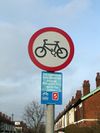National Cycle Network
| National Cycle Network | |
 | |
| Pictures related to National Cycle Network View gallery (6) | |
The National Cycle Network (NCN) forms a series of 'cycle friendly' routes that were championed by Sustrans from the early 1980s onwards. Whilst still developing, with several notable gaps, the network has blossomed to over 13,000 miles of a mixture of off-road and on-road cycle routes.
A brief history
The origins of the National Cycle Route can be traced to 1977, with the formation of Sustrans, a charity created to tackle the lack of adequate cycling provision in Bristol. Their first project, a conversion of a disused railway, opened in 1984 as the Bristol and Bath Railway Path . This 17 mile cycle trail was to create the foundations of the National Cycle Network's objectives, but it would be a decade later when National Lottery funding made expansion of the NCN viable.
The design aim for the NCN is that it can be ridden by "a competent 12 year old child cycling unaccompanied", rather than to provide additional facilities for existing road cyclists. NCN facilities range from long-distance "challenge" routes for leisure riding, such as the C2C and Lôn Las Cymru, to short-distance connections for commuters and local people, such as the bridges installed as part of the Lottery-funded Connect2 project.
Quality of routes
As a system of routes funded through a mixture of charitable funding, Local Transport Plan funding, and occasionally money raised from Section 278 agreements, the system is variable. Some sections of route use existing lightly trafficked roads, whereas others are on purpose built alignments that allow fast cycling, and yet more are on canal towpaths and require shared use with pedestrians, equestrians, and anglers.
Route numbering
The NCN is numbered using a trunk and branch system, with National Routes 1 to 8 in Great Britain, and Route 9 in Northern Ireland. Two digit routes link to their parent route, for example NCN Route 68 is a linked with NCN Route 6. Before 2009, there was a regional route classification, but this has begun to be phased out in favour of three digit national routes to avoid duplication of numbers.
Further links
Sustrans - National Cycle Network




